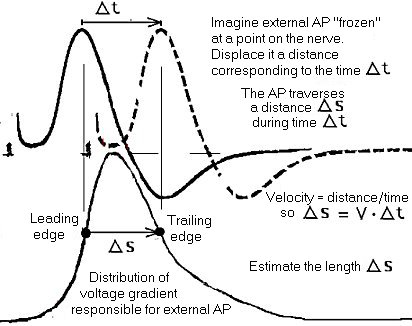The Nerve Impulse Seen from Outside
Dexter M. Easton July 2000 ©
Previous topic Table of Contents
Topic 29: The AP as a spatial event
The nerve impulse is a spatiotemporal electrochemical event. How long does it last, and how much length of nerve does it occupy? The display on the CRO shows its temporal aspect. The actual or virtual spacial extent of any part of it along the nerve can be estimated from the time course and the velocity of the impulse.
Figure 29. Length of the action potential.

Measure the time between two points on the AP record, for example, between the positive peak and the negative trough. Leaving the curve in place, inscribe a copy of it with the peak displaced that distance from the first. Thus we determine the time required for the peak to move to the point where its trough was, i.e. the time for the leading current maximum to reach the point where the trailing current was at maximum.
We have previously measured the velocity of the impulse, so we have velocity and elapsed time the impulse requires to travel any particular distance. From this information, we calculate the distance traversed during that interval. The length of the spike phase of the impulse generated by the type A fibers seems surprisingly long.
In some C fibers (for example of the olfactory nerve) in which the diameter may be only about 0.25 µm, the impulse velocity can be as low as l0 cm/sec. If the impulse length is 2 msec, what is the impulse length?
Next topic Previous topic Table of Contents
